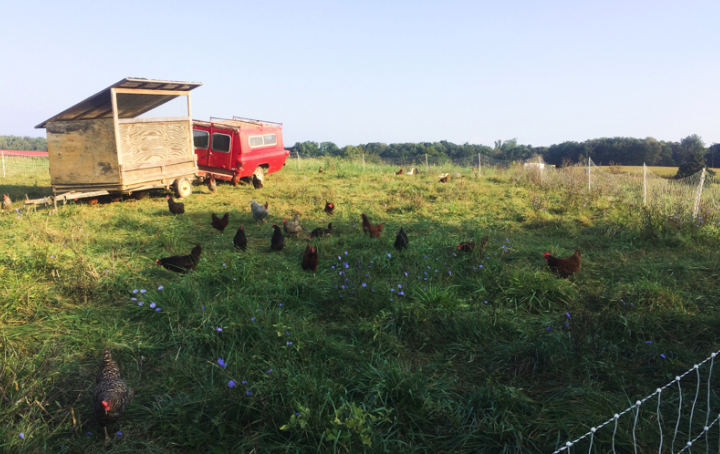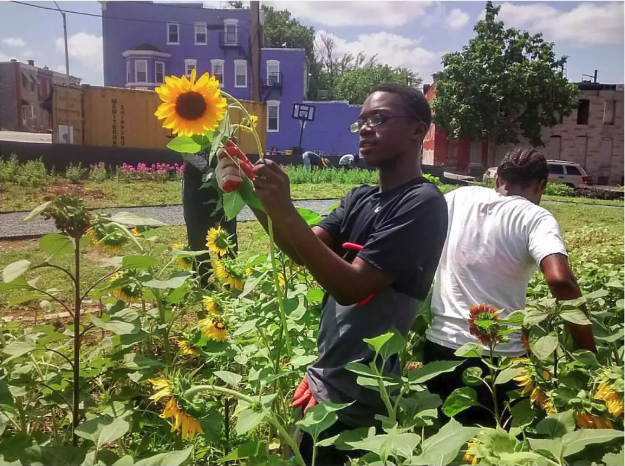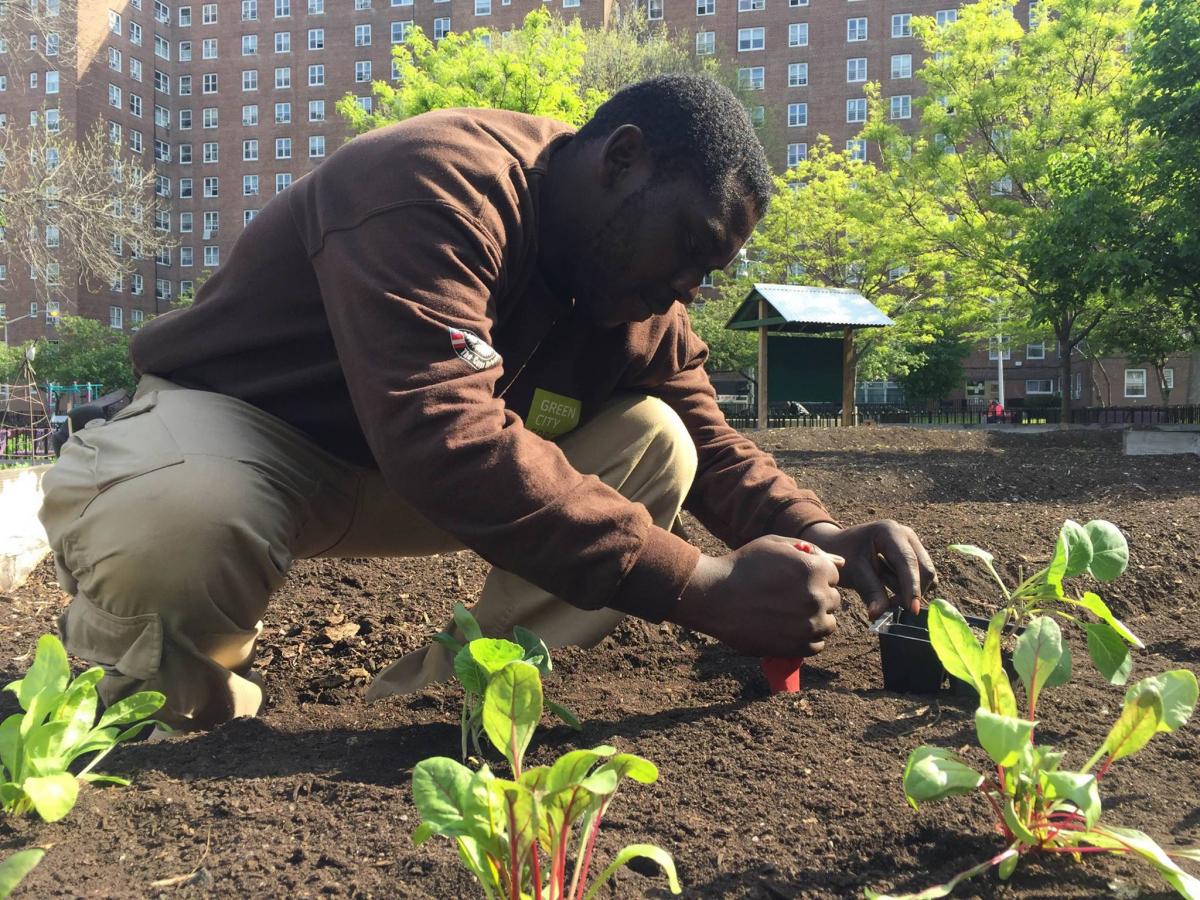
Blog by Ashley McNeil, Communications Assistant
For centuries, the connection between African-Americans and agriculture was tainted by the institution of slavery and the exploitative labor systems that continued in the years following the abolition of slavery. Even as African-Americans gained the right to own land, there were – and continue to be – institutional policies and practices that work against black farmers and land owners. In the modern day, however, farming has become a way for African-Americans to reclaim a piece of history and promote community health and healing. In this two-part series, we will explore what it means to be a black farmer. We will discuss history (Part I), as well as the modern black farming movement (Part II), by uncovering stories of heritage, lost and reclaimed.
PART II: Back to the Land

Modern Farmer
Engineer-turned-farmer Chris Newman left fast-paced Washington, D.C. for the quiet hills of Charlottesville, VA. In D.C., long hours and fast food halted his quest for a healthier life; he wanted to get outside and move around. Now, living on his farm in the country, he is healthier, eats dairy products again, and enjoys rising with the sun. Newman and his wife raise pigs, ducks, and chickens.
“Because I grow all this stuff, I tend to eat it. I don’t eat at Popeye’s anymore. I think it’s disgusting. I used to love Popeye’s. Now I can’t eat that crap,” Newman said.
The transition from engineering to farming was more a political act than for personal gain. Newman hopes to encourage other people of color to become farmers. He advocates for sustainable farm practices that enable access to healthy food for all communities. His main goal is to fix the system to be more inclusive: farming is more than 90 percent white and the second whitest job in the country. Visibility of African-Americans in this field is somewhat nonexistent.
“You go into Whole Foods around here, you don’t see black people; you go to farmers markets, don’t see that many black people; you go to farms, don’t see any black people.”
Newman suggests money and continued racism are the pitfall of inclusivity in farming. Newman’s produce is expensive: eggs sell for $5 a dozen. This price tag comes from the fact that his farm is completely organic, chemical, and preservative free. His animals fertilize the soil: the healthiest way to grow crops. Newman is quick to acknowledge his food is not affordable or accessible for everyone. In the United States, accessing fresh, healthy food can be particularly challenging for people living in low-income neighborhoods and communities of color. Lack of access to healthy food limits overall physical health. According to author Alan Yu, “African Americans are one and a half times as likely to be obese than white people, and they eat fewer vegetables than other racial groups.”
In this new profession, Newman has experienced racism and prejudice first hand. The cops were called on him when he delivered food to customers, and when he pulled over in a white neighborhood to eat his lunch. As he puts it, this is just part of farming while black. Even so, Newman continues to address the lack of diversity among farmers by hiring interns, prioritizing the recruitment of women and people of color from underrepresented communities.
“It’s about recognizing that there are barriers there for them that there aren’t for other people and that we need that lift, because the world is not our oyster,” he said.
Newman’s hard work paid off: last year his farm broke even. He hopes his story will be an example to people of color that they too can succeed in an industry that has previously taken not only their land, but their connection to the land.

Next Generation
Many black people have strayed from farming because of the legacy of land grabbing and forced labor. In an interview with VICE Impact, Walker Marsh, founder of Tha Flower Factory, a Baltimore initiative to grow local herbs and flowers, stated, “I used to equate land work to slavery. But the first day I started farming, I realized this was not slavery at all. When you can go out and create something, that’s true freedom to me.”
Marsh is one of many black farmers who have new joy in farming and use this work to diversify and reclaim a practice once corrupted with injustice.
According to black famers and activists alike, the revitalization of farming in the African-American community lies in the hands of youth. In partnership with the Chrysler Foundation, the National Black Farmers Association grants scholarships to encourage young people to get involved in farming.
“You don’t see black farmers,” said Marsh. “We don’t know what a black farmer looks like. When I was a kid, I pictured an old white dude with a pitchfork on a tractor. But now that I’ve been doing it, I’ve met black farmers I look up to.”
Representation and visibility are key to improving the number of African-American farmers. Local farmers Xavier Brown, Boe Luther, and Wallace Kirby, founders of Hustlaz to Harvesters, offer the formerly incarcerated a way out of poverty by introducing them to urban agriculture careers through the Dix Street community garden in Washington, D.C. The farm was created through the urban agricultural initiative Soilful City. Thirty-two garden beds serve the predominantly African-American community of Clay Terrace, home to 70,000 people. Like most low-income African-American communities, access to healthy, fresh produce was limited: there’s only one large grocery store. Most of these communities are food deserts. Through the garden, the community was rebuilt. Connection to healthy produce and cultural heritage were regained.
“Afro-ecology is reorientation of our connection to the land, an organizing principle, and the way we express our culture while we grow food and grow healthy people.” – Xavier Brown

Community Farming
A number of Corps engage in urban farming or have created community gardens to provide healthy produce to communities in need and train a young, more diverse generation of farmers.
Green City Force
Since 2012, Green City Force has worked with New York City Housing Authority to bring urban farming to low income communities. The Farms at NYCHA program is part of Building Healthy Communities (BHC), a city-wide partnership focused on improving health outcomes in 12 neighborhoods throughout the city. The farms, which are located on NYCHA properties, are designed to bring organic produce to food deserts and promote sustainable living in public housing communities. Their presence is intended to encourage residents to engage in local green spaces and start important conversations about food and environmental justice. The Corpsmembers who grow the food and maintain the gardens are also all NYCHA residents. Through the program, they gain valuable leadership and job skills.
Covering a total of five acres, the NYCHA farms have transformed formerly underutilized areas in low-income communities into lush green spaces that encourage active living and healthy eating. The farms project a spirit of togetherness; fruits and vegetables are distributed to public housing residents in exchange for volunteer time or household compost; over 20,000 residents benefit from this program.
Civic Works
Civic Works’ Real Food Farm initiative works towards a just and sustainable food system by improving access to food, providing education, and developing an economically viable and economically responsible local agriculture sector. Corpsmembers at Civic Works help transform abandoned lots throughout the city of Baltimore into community gardens and green spaces. They also grown local fresh food by managing an eight-acre farm at Clifton Park. Food access in the city is improved through the Corps’ Mobile Farmers Market, a converted delivery truck that sells fresh fruit and vegetables at community gathering locations, like schools and libraries. Since 2009, over 60,000 of food has been grown and over 3,000 people have been educated about gardening, sustainable agriculture and healthy eating.
Los Angeles Conservation Corps
From 2013 – 2017, the Little Green Fingers program, made possible through a grant from First 5 LA, sought to address the growing obesity epidemic in Los Angeles County by providing access to fresh fruit and vegetables to young at-risk children in low-income communities that are also considered “food deserts.” The goal was to help children and their families lead healthier lives and maintain healthier weights.
The LA Conservation Corps and partner organizations worked closely with the community to plan a garden. They considered everything from its layout, to amenities in the garden, to what crops to grow. Families applied to join the garden and played an active role in its construction.
Once constructed, Corpsmembers handled the final details – like ensuring the irrigation system worked, installing fencing, and constructing children’s play equipment – before handing over care of the garden to the community; many garden’s are still run by communities today.
For African-Americans, reclaiming connection to the land is, in fact, a political act. Instead of walking away from farming, and its history of hatred and discrimination, today’s community of African-American farmers recognize the past, and realize the importance of participating in building a future agricultural system that is inclusive, empowering, and capable of making healthy food more sustainable and accessible.
Resources
All sources cited in this piece can be found in the Moving Forward Initiative Resource Library.
For your consideration
- The vast majority of farm owners are white. What steps should be taken to generate more diversity and inclusivity in farming? How do we move forward?
- In what ways (if any) do you believe our agricultural system might be affected if farm ownership were more diverse?
- In what ways (if any) do you believe our agricultural system might be affected if farm ownership were more diverse?
- Newman states “farming while black” can be difficult. Why do you think there is a stigma around black farmers?
- Does unconscious bias play a role?
- Does unconscious bias play a role?
- In the last few years, community farming in low-income communities has boomed. What benefits could community farming bring to any community, not just low-income neighborhoods?


































































